Language change on firefox
How To Change Firefox Language

Have you thought of changing your Firefox language to a suitable language? Well, yes, it is possible and in this article, we are going to show you how to change Firefox language. You should have no issues in changing your Firefox language after reading this.
You would agree with me that not all Firefox users are comfortable with the default Firefox display language which is English. Some users may prefer Firefox in another language that’s why we have chosen to share this article for users to understand their ability to customize and modify their Mozilla Firefox browser.
Now, let’s stray away from the topic of today and have a quick understanding of what Firefox is.
Firefox can be defined as a free web browser developed by Mozilla and it is used to surf the World Wide Web easily in other to get/send information, download music, videos, apps etc. and also for communication purposes.
Firefox offers a very clean interface and super-fast downloading speed, it also records about 100 million users. Its interface is user-friendly and easy to operate.
Okay, time for the main business of showing you how to change Firefox language.
Don’t worry. We will make the steps easy and explicit.
How To Change Firefox Language
1. Open your Firefox browser.
2. Click on the menu button.
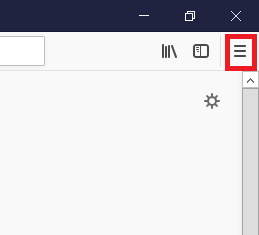
3. Click on options.
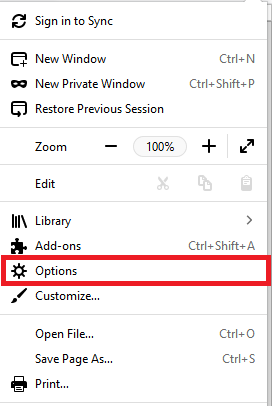
4. On the General tab, scroll down to language and appearance.
5. Click on Choose under Language
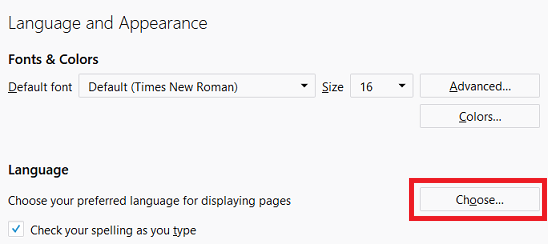
6. Click on “select a language to add”
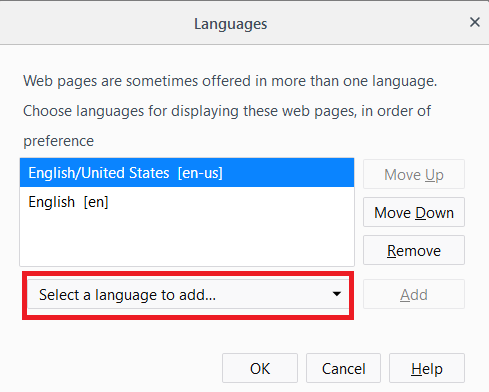
A list of Firefox preinstalled languages will be displayed. It contains about 240 dialects.
7. Select the language of your choice and click on Add.
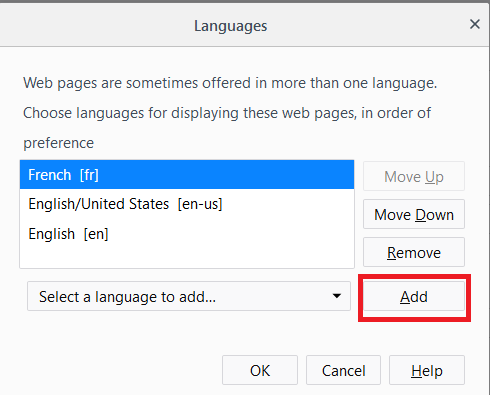
8. Restart your browser.
By now your new language should be added to the list. From observation, the new language displays first by default in order of preference.
You can change the order by using the Move Up and Move Down buttons provided. To remove a particular language from the preferred list options, select it and then click on the Remove button for it to be properly deleted.
If you are satisfied with the changes you have made, click the Ok button to take you back to preferences, once you are there, close the tab and continue your browsing session or input a new URL to start a new session.
Note: Not all page contents may support your preferred language.
And that’s a wrap people, I hope you all enjoyed reading this article as much I as loved writing it. Remember to show some love by sharing this article via social media platforms.
Frequently Asked Questions And Answers
Q: How many times can I change my Firefox language?
A: You can change your Firefox language as many times as you desire. There’s no limit.
Q: Is Firefox the same as Mozilla Firefox?
A: Yes, it is, Firefox is just a shorter way of calling Mozilla Firefox.
Q: If I move down the language I have just added, can I still choose it as my default language?
A: Yes, you can, it only comes up first because of its preferential order.
How to Change the Default Languages in Mozilla Firefox
Tell Firefox which language you prefer when viewing webpages
:max_bytes(150000):strip_icc()/ScottOrgera-f7aca23cc84a4ea9a3f9e2ebd93bd690.jpg)
:max_bytes(150000):strip_icc()/GettyImages-172628259-583cd28f5f9b58d5b1f568dd.jpg)
trait2lumiere / Getty Images
Some websites can be rendered in several different languages, depending on their configuration and your web browser’s abilities and settings. Firefox, which supports over 240 global dialects, provides the ability to specify which languages you prefer to use when viewing web content.
Before rendering text on a page, Firefox first validates whether or not it supports your preferred languages in the order that you specified them. If possible, the page’s verbiage is then displayed in your preferred language. Not all web pages are available in all languages.
How to Specify Preferred Languages in Firefox
Setting and modifying Firefox’s list of preferred languages can be done quickly. See the steps below:
In Firefox, select the hamburger (3 horizontal bars) at the top right corner of the menu bar.
You can also type about:preferences into the Firefox address bar.
:max_bytes(150000):strip_icc()/001-how-to-change-the-default-languages-in-mozilla-firefox-678fa681660f4c66b5df2869e2084523.jpg)
Select Options.
:max_bytes(150000):strip_icc()/002-how-to-change-the-default-languages-in-mozilla-firefox-d7a7e7bc508541ff835a0817024b8371.jpg)
In General preferences, scroll down to the Language and Appearance section.
:max_bytes(150000):strip_icc()/004-how-to-change-the-default-languages-in-mozilla-firefox-57039068642540b6bde61030ebbe68c7.jpg)
Under Language, select your desired language under Choose the languages used to display menus, messages, and notifications from Firefox by selecting Search for more languages.
:max_bytes(150000):strip_icc()/005-how-to-change-the-default-languages-in-mozilla-firefox-b1db88ed132b44949ac148d0e583726b.jpg)
In Firefox Language Settings, the browser’s current default language is shown in order of preference. To choose another language, select Select a language to add.
:max_bytes(150000):strip_icc()/003_change-default-languages-in-mozilla-firefox-4103602-5c34085346e0fb0001b2d680.jpg)
Scroll through the alphabetical language list and select the language of your choice. To move it into the active list, select Add.
Firefox users may still download a different language version of the web browser and install it over the current installation to change the language, but they don’t have to if they run Firefox Beta or Stable.
Firefox Nightly is excluded because strings change frequently in the browser.
- Load about:preferences in the browser’s address bar.
- Scroll down to the Language and Appearance section.
- The current interface language is displayed under language. Click on «Set Alternatives» to add additional languages to Firefox.
- Select «Select a language to add» and then «Search for more languages».
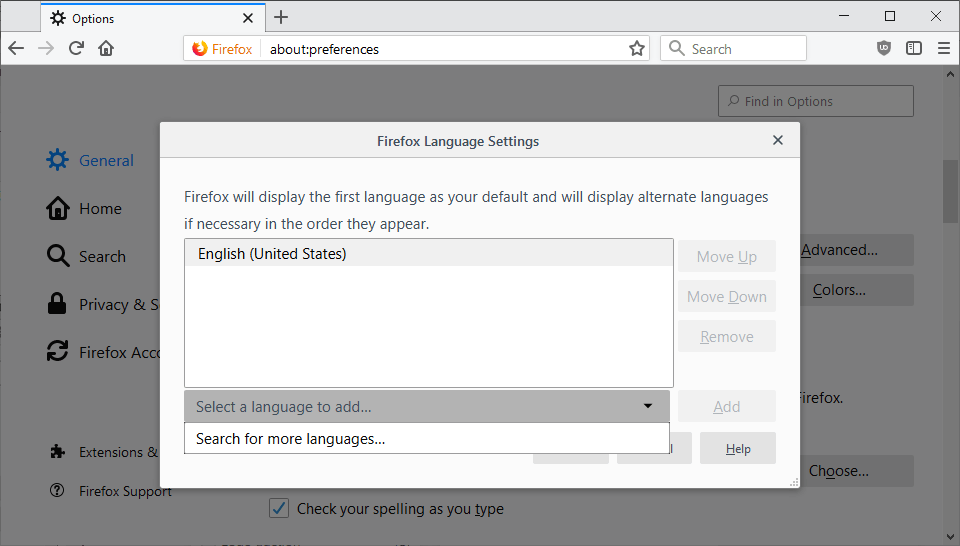

- Firefox retrieves the list of supported languages from Mozilla. Click on «select a language to add» and pick one of the available interface languages to add it as a language in Firefox.
- Tip: tap on the first letter of the language’s name to jump to the letter in the listing.
- Select Add to add the language. Firefox downloads the language pack from Mozilla and adds it to the browser. If a dictionary is available, it is also downloaded.
- Repeat the process for other languages that you may want to add.
- The order of languages determines the priority in which they will be used. You may use the move up or down buttons to change the order.
- Click on the ok button once you are done.
- Firefox displays a restart notification afterward if you changed the main display language. The restart notification is displayed in the old and new interface language. Select «apply and restart» to restart Firefox so that the new interface language is used.
The preference intl.locale.requested determines the priority of languages in Firefox. The preference is only available if two more more languages are installed in the browser.
Mozilla hopes to improve the process further in future versions of the Firefox web browser. One possibility that is discussed currently is to complete the migration to Fluent; this would enable restartless language switching and support for non-English fallback locales. Firefox falls back to English automatically if a string is missing from a language file.
Closing Words
The new language changing options in Firefox 65 improve the process significantly. Everything that is needed is included in Firefox or downloaded automatically from that version of the browser on.
While the total number of Firefox installations that have their interface language changed is unclear, it does not appear that uncommon of an operation.
Now You: Did you ever changed the interface language in a browser?
Digital Citizen
If you are not a native English speaker, you might want to use apps in your language. That includes any software, starting from your operating system to your favorite Office productivity suite and your primary web browser. If your browser of choice is Mozilla Firefox and you do not know how to change its user interface language, then you should read this guide. We show you two ways to get Firefox working in any language that you want:
NOTE: We assume that you already have Mozilla Firefox installed but it is not in the language that you want.
1. Download Mozilla Firefox in your language
The first and probably the easiest method to use Mozilla Firefox is to download it directly in your language and install it on top of the existing Firefox installation. To do that, visit this official Firefox website: Download Firefox in your language . It looks like this:
On this website, you can download Firefox in any of the 90 languages that it supports. To do so, enter the name of the language you want in the «Search languages» field, or scroll until you find it in the list beneath it.
After you find the language that you want, look on its right side. There, you have a series of links for Firefox, all in that language, but for different operating systems. Click or tap on the one that matches your operating system and its version (64-bit or 32-bit), and the download starts. For example, we want Firefox to use Romanian as display language, and we are using Windows 10 64-bit, so we have to download the Romanian Windows 64-bit version of Firefox.
NOTE: If you do not know what version of Windows you have, this guide can help you figure it out: What version of Windows do I have installed? .
Once you download the Firefox installer file, run it and follow the steps of the install wizard. In the end, you should have a fully functional Firefox that displays its user interface in the language that you chose.
2. Download a language pack for Mozilla Firefox’s user interface and enable it in its settings
Another method that works just as well and which some people might prefer is to download, install and enable a language pack for their Mozilla Firefox browser. Open Firefox and visit this website: Firefox Add-ons — Dictionaries and Language Packs . It looks like this:
On it, there is a long list with all the languages in which Firefox’s interface can be used. Scroll down until you find the one you want, and then click or tap the Language Pack link to its right.
The previous action takes you to that language pack’s webpage. On it, click or tap the «+ Add to Firefox» button.
Firefox now asks if you want to add that language pack (add-on) to Firefox. Click or tap Add to continue.
After the language pack has been added to your Firefox, click or tap on OK to close the dialog.
Now, all it remains for us to do is to enable the new language and make Firefox use it for its user interface.
To do so, open a new tab and type about:config in its address bar. Then press Enter on your keyboard.
Firefox might show a warning that «This might void your warranty!» because you are about to change advanced settings. This warning may not be in English, but in a different language, depending on what you have installed on your PC. Click or tap «I accept the risk!» or the only blue button that you see.
Firefox shows you a long list with advanced settings that you can change. It looks like this:
In the Search field at the top, type intl.locale.requested or copy and paste this text. This filters the list of settings and should show only one setting, named intl.locale.requested. Double-click or double-tap on it and Firefox opens a small window in which the current display language code is shown. For example, if Firefox is now using US English, you should see en-us.
Delete the current language code and, in its place, type the code of the language pack that you want to switch to. Then, click or tap on OK. For example, we want Firefox to use Romanian as a display language, and its code is ro. So, we have to type ro and press OK.
If you do not know the code for the language pack that you have installed and wanted to activate, you can find the list of all the language codes here: Mozilla Web Localization Dashboard .
Once you entered the language code and pressed OK, all that remains for you to do is close Firefox completely (all its windows) and restart it. When you restart it, Firefox is using the new display language.
What to do if you do not find the «intl.locale.requested» setting in the «about:config» tab
There are situations that we also stumbled upon, in which Firefox does not show you anything when you are searching for the intl.locale.requested setting in the about:config tab. We know for sure that this happens in the last version of Firefox that we used: Firefox 61 (64-bit).
However, that does not mean that you cannot use this method to change the display language. There is, however, an additional step that you must perform, and that is to create the intl.locale.requested setting yourself. In the about:config tab, right-click anywhere in the list of settings (or on any setting), and you should see a small contextual menu. In it, click or tap on New and then String. If Firefox is in a language that you do not understand, click the only option with an arrow on its right (it is the fifth when going from top to bottom), and then in the submenu that opens, choose the first value from the top. This is always the equivalent of choosing New and then String.
In the «New string value» window, type intl.locale.requested, and then press OK.
Firefox then asks you to «Enter string value.» Type the language code for the language pack that you installed previously and which you want Firefox to use to display the user interface.
Click or tap OK and restart Firefox. Then, your favorite web browser displays its user interface in the new language that you installed and enabled.
Did you switch the interface language for Mozilla Firefox?
These are the two ways that we know for changing the language used by Firefox to display its user interface. Do you know others too? Did you find it easy to change Firefox’s display language? Share your thoughts, opinions or questions, in the comments section below.



